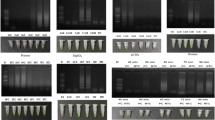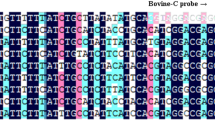Abstract
A TaqMan probe real-time polymerase chain reaction assay was developed for the determination of pork adulteration in commercial burgers. The assay combined porcine-specific primers and TaqMan probe for the selective amplification and detection of a 109-bp fragment of swine cytochrome b (cytb) gene. Specificity test with 10 ng DNA of 11 different meat-providing animal and fish species yielded a quantification cycle (Cq) of 15.5 ± 0.20 for the pork and negative results for the others in a 40-cycle reaction with a change of analysts and sources. Analysis of beef burger formulations with spiked pork showed the assay can determine 100–0.01% contaminated pork with a PCR efficiency (E) of 93.8% and a correlation coefficient (R 2) of 0.991. A plot of actual value against real-time PCR-predicted value also yielded a good linear regression, R 2 0.998, and small root mean square error of calibration, RMSEC 0.42. A strong correlation was found between the partial least square (PLS)-predicted values and real-time PCR-determined values. The accuracy of the method was ≥90% in all determinations of the standard set. Residual analysis also revealed a high precision in all determinations. Finally, a random analysis of 10 ng DNA of commercial burgers from pork, beef, chicken, mutton, and chevon yielded a Cq of 15.56 ± 0.22 to 16.24 ± 0.35 from pork burgers, and negative results from the others, showing the suitability of the assay to determine pork in commercial burgers with a high accuracy and precision.






Similar content being viewed by others
References
Aboud MJ, Gassmann M, McCord BR (2010) Development of mini pentameric STR loci for rapid analysis of forensic DNA samples on a microfluidic system. Electrophoresis 31:2672
An L, Deng J, Zhou L, Li H, Chen F, Wang H, Liu Y (2010) Simultaneous spectrophotometric determination of trace amount of malachite green and crystal violet in water after cloud point extraction using partial least square regression. J Hazards Mater 175:883
Ali ME, Hashim U, Mustafa S et al (2011a) Nanoparticle sensor for label free detection of swine DNA in mixed biological samples. Nanotechnology 22:195503
Ali ME, Hashim U, Mustafa S (2011b) Nanobiosensor for detection and quantification of DNA sequences in degraded mixed meats. J Nanomater 2011:781098
Ali ME, Hashim U, Mustafa S, Che Man YB (2011c) Swine-specific PCR–RFLP assay targeting mitochondrial cytochrome b gene for semiquantitative detection of pork in commercial meat products Food Anal Method doi:10.1007/s12161-011-9290-5
Ali ME, Hashim U, Mustafa S, Che Man YB, Islam KhN (2012) Gold nanoparticle sensor for the visual detection of pork adulteration in meatball formulation J Nanomater 2012:103607
Aida AA, Che Man YB, Wong CMVL, Raha AR, Son R (2005) Analysis of raw meats and fats of pigs using polymerase chain reaction for Halal authentication. Meat Sci 69:47–52
Asensio L, González I, García T, Martín R (2008) Determination of food authenticity by enzyme-linked immunosorbent assay (ELISA). Food Control 19(1):1
Bielikova M, Pangallo D, Turna J (2010) Polymerase chain reaction–restriction fragment length polymorphism (PCR-RFLP) as a molecular discrimination tool for raw and heat-treated game and domestic animal meats. J Food Nutr Res 49(3):134
Che Man YB, Mustafa S, Khairil Mokhtar NF, Nordin R, Sazili AQ (2010) Porcine-specific polymerase chain reaction assay based on mitochondrial D-loop gene for the identification of pork in raw meat Int J Food Prop doi: 10.1080/10942911003754692
Chen FC, Hsieh YHP, Bridgman RC (2004) Monoclonal antibody-based sandwich enzyme-linked immunosorbent assay for sensitive detection of prohibited ruminant proteins in feedstuffs. J Food Prot 67(3):544
Doosti A, Ghasemi Dehkordi P, Rahimi E (2011) Molecular assay to fraud identification of meat products. J Food Sci Technol. doi:10.1007/s13197-011-0456-3
European Commission (2002) Council regulation (EC) No 178/2002 of 28 January 2002 laying down the general principles and requirements of food law, establishing the European Food Safety Authority and laying down procedures in matters of food safety. Off J Euro Comn I 31:1
Fajardo V, González I, Rojas M, García T, Martín R (2010) A review of current PCR-based methodologies for the authentication of meats from game animal species. Trends Food Sci Tech 21(8):408
Fajardo V, González I, Martín I et al (2008) Real-time PCR for detection and quantification of red deer (Cervus elaphus), fallow deer (Dama dama), and roe deer (Capreolus capreolus) in meat mixtures. Meat Sci 79(2):289
Farrokhi R, Jafari Joozani R (2011) Identification of pork genome in commercial meat extracts for Halal authentication by SYBR green I real-time PCR. Int J Food Sci Tech 46(5):951
Forell SCP, Ranalli N, Zaritzky NE, Andrez SC, Califano AN (2010) Effect of type of emulsifiers and antioxidants on oxidative stability, colour and fatty acid profile of low-fat beef burgers enriched with unsaturated fatty acids and phytosterols. Meat Sci 86:364
Haaland DM, Thomas EV (1988) Partial least-square methods for spectral analyses. 1 Relation to other quantitative calibration methods and the extraction of qualitative information. Anal Chem 60:1193
Hird H, Chisholm A, Sanchez A, Harnandez M, Goodier R, Schneede K, Boltz C, Popping B (2006) Effect of heat and pressure processing on DNA fragmentation and implications for the detection of meat using a real-time polymerase chain reaction. Food Addit Contam A 23(7):645
Köppel R, Ruf J, Rentsch J (2011) Multiplex real-time PCR for the detection and quantification of DNA from beef, pork, horse and sheep. Eur Food Res Technol 232(1):151
Murugaiah C, Noor ZM, Mastakim M, Bilung LM, Selamat J, Son R (2009) Meat species identification and Halal authentication analysis using mitochondrial DNA. Meat Sci 83:57
Nevado JJB, Flores JR, penalvo GC (1997) Simultaneous spectrophotometric determination of ethinylestradiol and lenvonorgestrel by partial least squares and principal component regression multivariate calibration. Anal Chim Acta 340:257
Nurjuliana M, Che Man YB, Mat Hashim D, Mohamed AKS (2011) Rapid identification of pork for Halal authentication using the electronic nose and gas chromatography mass spectrometer with headspace analyzer. Meat Sci 88(4):638
Otto M, Wegscheider W (1985) Spectrophotometric multicomponent analysis applied to trace metal determinations. Anal Chem 57:63
Rohman A, Sismindary EY, Che Man YB (2011) Analysis of pork adulteration in beef meatball using Fourier transform infrared (FTIR) spectroscopy. Meat Sci 88:91
Regenstein JM, Chaudry MM, Regenstein CE (2003) The Kosher and Halal food laws. Compr Rev Food Sci F 2:111
Rodriguez MA, Garcia T, Gonzalez I, Asensio L, Harnandez PE, Martin R (2005) TaqMan real-time PCR for the detection and quantification pork in meat mixtures. Meat Sci 70:113
Rojas M, Gonzalez I, Pavon MA et al (2010) Novel TaqMan real-time polymerase chain reaction assay for verifying the authenticity of meat and commercial meat products from game birds. Food Addit Contam A 27:749
Sakai Y, Kotoura S, Yano T et al (2011) Quantification of pork, chicken and beef by using a novel reference molecule. Biosci Biotechnol Biochem. doi:10.1271/bbb.110024
Smith S, Vigilant L, Morin PA (2002) The effects of sequence length and oligonucleotide mismatches on 5′ exonuclease assay efficiency. Nucleic Acids Res 30:e111
Tanabe S, Hase M, Yano T, Sato M, Fujimaru T, Akiyama H (2007) A real-time quantitative PCR detection method for pork, chicken, beef, mutton, and horseflesh in Foods. Biosci Biotechnol Biochem 71(12):3131
Wong EH-K, Hanner RH (2008) DNA barcoding detects market substitution in North American seafood. Food Res Int 41:828
Wu J-H, Hong P-Y, Liu W-T (2009) Quantitative effects of position and type of single mismatch on single base primer extension. J Microbiol Meth 77:267
Yusop MHM, Mustafa S, Che Man YB, Omar AR, Khairil Moktar NF (2011) Detection of raw pork targeting porcine-specific mitochondrial cytochrome b gene by molecular beacon probe real-time polymerase chain reaction Food Anal Method doi: 10.1007/s1261-011-9260-y
Acknowledgement
M.E. Ali is a recipient of a Graduate Assistanceship from Universiti Malaysia Perlis. The project was supported by “RUGS grant no. 9031” to Prof. Y.B. Che Man and “MOSTI grant no. 05-01-35-SF-1030” to Prof. U. Hashim.
Author information
Authors and Affiliations
Corresponding author
Rights and permissions
About this article
Cite this article
Ali, M.E., Hashim, U., Dhahi, T.S. et al. Analysis of Pork Adulteration in Commercial Burgers Targeting Porcine-Specific Mitochondrial Cytochrome B Gene by TaqMan Probe Real-Time Polymerase Chain Reaction. Food Anal. Methods 5, 784–794 (2012). https://doi.org/10.1007/s12161-011-9311-4
Received:
Accepted:
Published:
Issue Date:
DOI: https://doi.org/10.1007/s12161-011-9311-4




